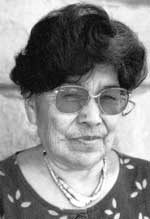Priscilla Namingha facts for kids
Quick facts for kids
Priscilla Namingha Nampeyo
|
|
|---|---|
 |
|
| Born | 1924 |
| Died | 2008 (aged 83–84) |
| Nationality | Hopi |
| Known for | Pottery |
Priscilla Namingha Nampeyo (1924 – 2008) was a talented Hopi-Tewa artist. She was famous for making beautiful, traditional pottery. Priscilla even dug up her own clay and made her own special colors for her big pots. Today, her amazing artwork can be seen in many museums and cultural places.
Contents
Priscilla's Early Life and Family
Priscilla Namingha was born in 1924. She was part of the Hopi-Tewa people and lived in Polacca, on First Mesa. Priscilla was the oldest daughter of Rachel Namingha. Her sisters, Dextra Quotskuyva, Lillian Gonzales, and Elenor Lucas, were all potters too.
Priscilla was also the great-granddaughter of a very famous potter named Nampeyo. Her own daughters later became potters as well, continuing the family tradition. Priscilla said she learned how to make pottery by watching her mother work. When she was a young girl, she also learned special pottery skills from her great-grandmother, Nampeyo. Priscilla continued making pottery almost until she passed away in 2008.
How Priscilla Created Pottery
Priscilla Namingha's pottery followed the long-standing traditions of the Nampeyo family. Her pots often featured "fine-line" designs. These patterns were inspired by birds and feathers. Priscilla used about 20 of the traditional designs that her great-grandmother Nampeyo had created.
Her pots were often quite large, sometimes more than 20 inches across. This made them very impressive!
Materials Priscilla Used
Priscilla used clay that she dug herself from First Mesa. She prepared the clay by grinding it into a fine powder. Then, she added ground sandstone to the mixture. This made the clay strong and ready for shaping.
For the black paint on her pots, she used a plant called the Rocky Mountain bee plant. To get a reddish color for her designs, she used a special yellow rock. She painted all these beautiful designs using a brush made from a yucca plant.
Firing the Pottery
After shaping and painting her pots, Priscilla would fire them in the ground. First, she would burn wood to create charcoal. Then, she would carefully place about 8 to 10 pots on top of the hot coals. She added sheep dung around and on top of the pots.
To help air move around, she placed pot shards (broken pieces of pottery) and rocks between the pots. Then, she added even more sheep dung on top. The pots would then slowly bake in the fire pit for several hours. This process made them hard and durable.
Where to See Her Work
Priscilla Namingha gave pottery demonstrations and showed her artwork at the Maxwell Museum of Anthropology. Her work is also part of several important collections. You can find her pottery at the Morgan Collection of Southwest Pueblo Pottery, the Heard Museum, the Hopi Cultural Center Museum, and the Museum of Northern Arizona.

